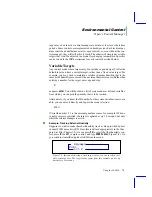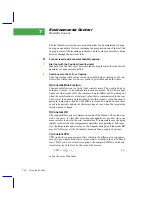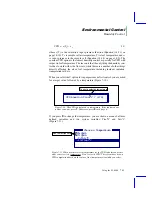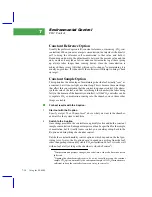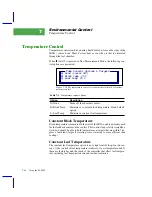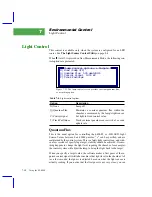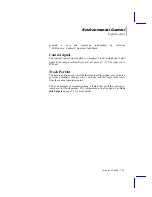
Environmental Control
Humidity Control
7-10
Using the LI-6400
7
The leaf chamber water vapor concentration that can be maintained is depen-
dent upon a number of factors, including the transpiration rate of the leaf, the
vapor pressure of the incoming air stream, and the volume of air that is being
diverted through the desiccant tube.
■
■
■
■
For best results with constant humidity options:
1
Start out with the F option (fixed flow rate)
Manually find the flow rate / desiccant tube setting that provides the desired
humidity or vapor pressure deficit.
2
Switch over to the H, R, or V option.
Your target value will be close to what is actually being achieved, so the con-
trol system will not have to do very much to get it there and hold it there.
H) Constant Mole Fraction
Constant mole fraction is a fairly tight control circuit. The work is done by
hardware circuitry, so no software intervention is needed. The software does
figure out what signal (mV) the sample cell water IRGA will be putting out
when the mole fraction is at the target value; this is communicated to the con-
trol circuit via an analog output signal. Since this signal is also a function of
pressure, temperature, and how the IRGA is zeroed and matched, then there
needs to be periodic updates of this target signal, even when the target mole
fraction doesnÕt change.
R) Constant RH
The constant RH control is a simple extension of the H mode. The actual con-
trol is the same, itÕs just that more frequent updates are needed, since one
more variable is now in the mix: temperature. If temperatures are changing
rapidly (such as when the temperature controllers are operating at full capac-
ity), the temperature updates may not be frequent enough, and the actual RH
may drift off target a little bit (usually not more than a couple of percent).
V) Constant VPD
VPD stands for vapor pressure deficit, which is the difference in vapor pres-
sure between what could be
there
versus what is actually in the air. Where is
there
? Well, you have at least two options: the sample cell IRGA, or the sub-
stomatal cavity of the leaf. In the case of the former,
(7-1)
and in the case of the latter,
VPD
e T
a
(
)
e
s
Ð
=
Summary of Contents for LI-6400
Page 1: ...Using the LI 6400 Portable Photosynthesis System ...
Page 15: ...Part I The Basics ...
Page 16: ......
Page 174: ...Making Measurements Answers to Questions 4 56 Using the LI 6400 4 ...
Page 175: ...Part II Useful Details ...
Page 176: ......
Page 200: ...Standard Tools Power ON Hooks 5 24 Using the LI 6400 5 ...
Page 214: ...Real Time Data Real Time Graphics 6 14 Using the LI 6400 6 ...
Page 234: ...Environmental Control Light Control 7 20 Using the LI 6400 7 ...
Page 244: ...Light Sensor Considerations Gallium Arsenide Phosphide GaAsP Sensor 8 10 Using the LI 6400 8 ...
Page 288: ...Data Logging Making Your Own AutoPrograms 9 44 Using the LI 6400 9 ...
Page 289: ...Part III Working With Files ...
Page 290: ......
Page 312: ...The LPL File System Troubleshooting 10 22 Using the LI 6400 10 ...
Page 340: ...Downloading Files Using a Data Capture Program 11 28 Using the LI 6400 11 ...
Page 375: ...Part IV Configuration Issues ...
Page 376: ......
Page 420: ...Defining User Variables Old Style vs New Style 15 18 Using the LI 6400 15 ...
Page 454: ...Using an Energy Balance Further Reading 17 12 Using the LI 6400 17 ...
Page 455: ...Part V Maintenance Troubleshooting ...
Page 456: ......
Page 572: ...Troubleshooting Useful Information 20 46 Using the LI 6400 20 ...
Page 593: ...Part VI Programming ...
Page 594: ......
Page 622: ...Programming with LPL Compiler Directives 22 28 Using the LI 6400 22 ...
Page 846: ...Index I 16 Using the LI 6400 ...










